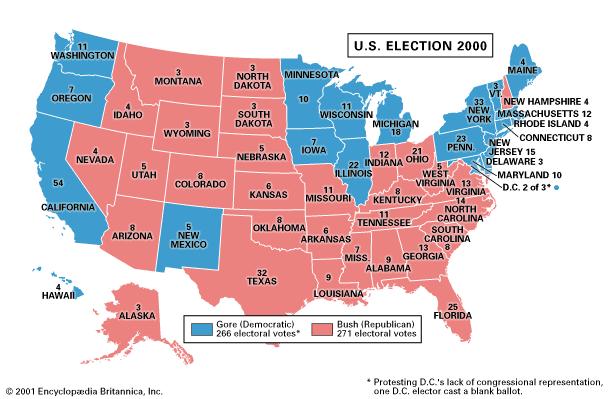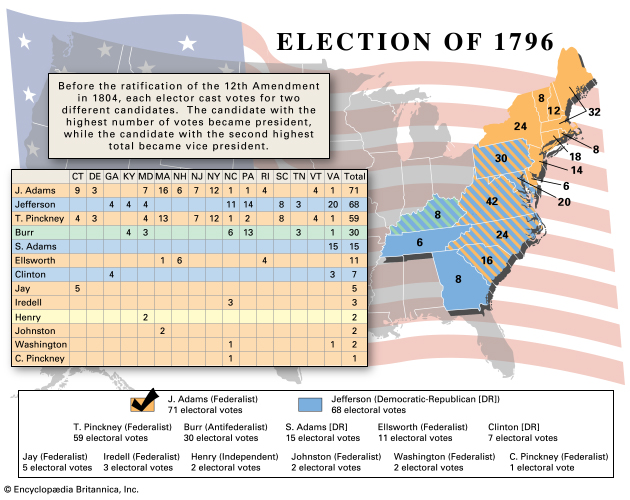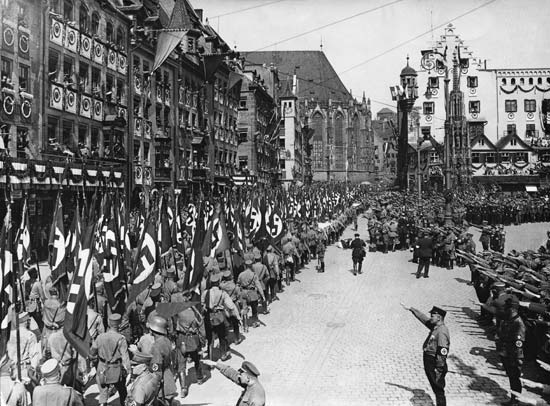Presidency of the United States of America, chief executive office of the United States. In contrast to many countries with parliamentary forms of government, where the office of president, or head of state, is mainly ceremonial, in the United States the president is vested with great authority and is arguably the most powerful elected official in the world. The nation’s founders originally intended the presidency to be a narrowly restricted institution. They distrusted executive authority because their experience with colonial governors had taught them that executive power was inimical to liberty, because they felt betrayed by the actions of George III, the king of Great Britain and Ireland, and because they considered a strong executive incompatible with the republicanism embraced in the Declaration of Independence (1776). Accordingly, their revolutionary state constitutions provided for only nominal executive branches, and the Articles of Confederation (1781–89), the first “national” constitution, established no executive branch. For coverage of the 2012 election, see United States Presidential Election of 2012.
- Hubert Humphrey outlines some of the most dramatic ways in which American presidents have used the …Encyclopædia Britannica, Inc.
Duties of the office
The Constitution succinctly defines presidential functions, powers, and responsibilities. The president’s chief duty is to make sure that the laws are faithfully executed, and this duty is performed through an elaborate system of executive agencies that includes cabinet-level departments. Presidents appoint all cabinet heads and most other high-ranking officials of the executive branch of the federal government. They also nominate all judges of the federal judiciary, including the members of the Supreme Court. Their appointments to executive and judicial posts must be approved by a majority of the Senate (one of the two chambers of Congress, the legislative branch of the federal government, the other being the House of Representatives). The Senate usually confirms these appointments, though it occasionally rejects a nominee to whom a majority of members have strong objections. The president is also the commander in chief of the country’s military and has unlimited authority to direct the movements of land, sea, and air forces. The president has the power to make treaties with foreign governments, though the Senate must approve such treaties by a two-thirds majority. Finally, the president has the power to approve or reject (veto) bills passed by Congress, though Congress can override the president’s veto by summoning a two-thirds majority in favour of the measure.
Historical development
By the time the Constitutional Convention assembled in Philadelphia on May 25, 1787, wartime and postwar difficulties had convinced most of the delegates that an energetic national executive was necessary. They approached the problem warily, however, and a third of them favoured a proposal that would have allowed Congress to select multiple single-term executives, each of whom would be subject to recall by state governors. The subject consumed more debate at the convention than any other. The stickiest points were the method of election and the length of the executive’s term. At first, delegates supported the idea that the executive should be chosen by Congress; however, congressional selection would make the executive dependent on the legislature unless the president was ineligible for reelection, and ineligibility would necessitate a dangerously long term (six or seven years was the most common suggestion).
The delegates debated the method of election until early September 1787, less than two weeks before the convention ended. Finally, the Committee on Unfinished Parts, chaired by David Brearley of New Jersey, put forward a cumbersome proposal—the electoral college—that overcame all objections. The system allowed state legislatures—or the voting public if the legislatures so decided—to choose electors equal in number to the states’ representatives and senators combined; the electors would vote for two candidates, one of whom had to be a resident of another state. Whoever received a majority of the votes would be elected president, the runner-up vice president. If no one won a majority, the choice would be made by the House of Representatives, each state delegation casting one vote. The president would serve a four-year term and be eligible for continual reelection (by the Twenty-second Amendment, adopted in 1951, the president was limited to a maximum of two terms).
Until agreement on the electoral college, delegates were unwilling to entrust the executive with significant authority, and most executive powers, including the conduct of foreign relations, were held by the Senate. The delegates hastily shifted powers to the executive, and the result was ambiguous. Article II, Section 1, of the Constitution of the United States begins with a simple declarative statement: “The executive Power shall be vested in a President of the United States of America.” The phrasing can be read as a blanket grant of power, an interpretation that is buttressed when the language is compared with the qualified language of Article I: “All legislative Powers herein granted shall be vested in a Congress of the United States.”

This loose construction, however, is mitigated in two important ways. First, Article II itemizes, in sections 2 and 3, certain presidential powers, including those of commander in chief of the armed forces, appointment making, treaty making, receiving ambassadors, and calling Congress into special session. Had the first article’s section been intended as an open-ended authorization, such subsequent specifications would have made no sense. Second, a sizable array of powers traditionally associated with the executive, including the power to declare war, issue letters of marque and reprisal, and coin and borrow money, were given to Congress, not the president, and the power to make appointments and treaties was shared between the president and the Senate.
The delegates could leave the subject ambiguous because of their understanding that George Washington (1789–97) would be selected as the first president. They deliberately left blanks in Article II, trusting that Washington would fill in the details in a satisfactory manner. Indeed, it is safe to assert that had Washington not been available, the office might never have been created.
Postrevolutionary period
Scarcely had Washington been inaugurated when an extraconstitutional attribute of the presidency became apparent. Inherently, the presidency is dual in character. The president serves as both head of government (the nation’s chief administrator) and head of state (the symbolic embodiment of the nation). Through centuries of constitutional struggle between the crown and Parliament, England had separated the two offices, vesting the prime minister with the function of running the government and leaving the ceremonial responsibilities of leadership to the monarch. The American people idolized Washington, and he played his part artfully, striking a balance between “too free an intercourse and too much familiarity,” which would reduce the dignity of the office, and “an ostentatious show” of aloofness, which would be improper in a republic.
But the problems posed by the dual nature of the office remained unsolved. A few presidents, notably Thomas Jefferson (1801–09) and Franklin D. Roosevelt (1933–45), proved able to perform both roles. More common were the examples of John F. Kennedy (1961–63) and Lyndon B. Johnson (1963–69). Although Kennedy was superb as the symbol of a vigorous nation—Americans were entranced by the image of his presidency as Camelot—he was ineffectual in getting legislation enacted. Johnson, by contrast, pushed through Congress a legislative program of major proportions, including the Civil Rights Act of 1964, but he was such a failure as a king surrogate that he chose not to run for a second term.
Washington’s administration was most important for the precedents it set. For example, he retired after two terms, establishing a tradition maintained until 1940. During his first term he made the presidency a full-fledged branch of government instead of a mere office. As commander in chief during the American Revolutionary War, he had been accustomed to surrounding himself with trusted aides and generals and soliciting their opinions. Gathering the department heads together seemed a logical extension of that practice, but the Constitution authorized him only to “require the Opinion, in writing” of the department heads; taking the document literally would have precluded converting them into an advisory council. When the Supreme Court refused Washington’s request for an advisory opinion on the matter of a neutrality proclamation in response to the French revolutionary and Napoleonic wars—on the ground that the court could decide only cases and not controversies—he turned at last to assembling his department heads. Cabinet meetings, as they came to be called, remained the principal instrument for conducting executive business until the late 20th century, though some early presidents, such as Andrew Jackson (1829–37), made little use of the cabinet.
The Constitution also authorized the president to make treaties “by and with the Advice and Consent of the Senate,” and many thought that this clause would turn the Senate into an executive council. But when Washington appeared on the floor of the Senate to seek advice about pending negotiations with American Indian tribes, the surprised senators proved themselves to be a contentious deliberative assembly, not an advisory board. Washington was furious, and thereafter neither he nor his successors took the “advice” portion of the clause seriously.
At about the same time, it was established by an act of Congress that, though the president had to seek the approval of the Senate for his major appointments, he could remove his appointees unilaterally. This power remained a subject of controversy and was central to the impeachment of Andrew Johnson (1865–69) in 1868. (In 1926, in Myers v. United States, the Supreme Court, in a decision written by Chief Justice and former president William Howard Taft, overturned an 1876 law that required the president to receive senatorial consent to remove a postmaster, thus affirming the right of a president to remove executive officers without approval of the Senate.)
Washington set other important precedents, especially in foreign policy. In his Farewell Address (1796) he cautioned his successors to “steer clear of permanent alliances with any portion of the foreign world” and not to “entangle our peace and prosperity in the toils of European ambition, rivalship, interest, humor, or caprice.” His warnings laid the foundation for America’s isolationist foreign policy, which lasted through most of the country’s history before World War II, as well as for the Monroe Doctrine.
Perils accompanying the French revolutionary wars occupied Washington’s attention, as well as that of his three immediate successors. Americans were bitterly divided over the wars, some favouring Britain and its allies and others France. Political factions had already arisen over the financial policies of Washington’s secretary of the treasury, Alexander Hamilton, and from 1793 onward animosities stemming from the French Revolution hardened these factions into a system of political parties, which the framers of the Constitution had not contemplated.
The emergence of the party system also created unanticipated problems with the method for electing the president. In 1796 John Adams (1797–1801), the candidate of the Federalist Party, won the presidency and Thomas Jefferson (1801–09), the candidate of the Democratic-Republican Party, won the vice presidency; rather than working with Adams, however, Jefferson sought to undermine the administration. In 1800, to forestall the possibility of yet another divided executive, the Federalists and the Democratic-Republicans, the two leading parties of the early republic, each nominated presidential and vice presidential candidates. Because of party-line voting and the fact that electors could not indicate a presidential or vice presidential preference between the two candidates for whom they voted, the Democratic-Republican candidates, Jefferson and Aaron Burr, received an equal number of votes. The election was thrown to the House of Representatives, and a constitutional crisis nearly ensued as the House became deadlocked. On February 17, 1801, Jefferson was finally chosen president by the House, and with the ratification of the Twelfth Amendment, beginning in 1804, electors were required to cast separate ballots for president and vice president.
The presidency in the 19th century
Jefferson shaped the presidency almost as much as did Washington. He altered the style of the office, departing from Washington’s austere dignity so far as to receive foreign ministers in run-down slippers and frayed jackets. He shunned display, protocol, and pomp; he gave no public balls or celebrations on his birthday. By completing the transition to republicanism, he humanized the presidency and made it a symbol not of the nation but of the people. He talked persuasively about the virtue of limiting government—his first inaugural address was a masterpiece on the subject—and he made gestures in that direction. He slashed the army and navy, reduced the public debt, and ended what he regarded as the “monarchical” practice of addressing Congress in person. But he also stretched the powers of the presidency in a variety of ways. While maintaining a posture of deference toward Congress, he managed legislation more effectively than any other president of the 19th century. He approved the Louisiana Purchase despite his private conviction that it was unconstitutional. He conducted a lengthy and successful war against the Barbary pirates of North Africa without seeking a formal declaration of war from Congress. He used the army against the interests of the American people in his efforts to enforce an embargo that was intended to compel Britain and France to respect America’s rights as a neutral during the Napoleonic wars and ultimately to bring those two countries to the peace table. In 1810 Jefferson wrote in a letter that circumstances “sometimes occur” when “officers of high trust” must “assume authorities beyond the law” in keeping with the “salus populi…, the laws of necessity, of self-preservation, of saving our country when in danger.” On those occasions “a scrupulous adherence to written law, would be to lose the law itself…thus absurdly sacrificing the end to the means.”
From Jefferson’s departure until the end of the century, the presidency was perceived as an essentially passive institution. Only three presidents during that long span acted with great energy, and each elicited a vehement congressional reaction. Andrew Jackson exercised the veto flamboyantly; attempted, in the so-called Bank War, to undermine the Bank of the United States by removing federal deposits; and sought to mobilize the army against South Carolina when that state adopted an Ordinance of Nullification declaring the federal tariffs of 1828 and 1832 to be null and void within its boundaries. By the time his term ended, the Senate had censured him and refused to receive his messages. (When Democrats regained control of the Senate from the Whigs, Jackson’s censure was expunged.) James K. Polk (1845–49) maneuvered the United States into the Mexican War and only later sought a formal congressional declaration. When he asserted that “a state of war exists” with Mexico, Senator John C. Calhoun of South Carolina launched a tirade against him, insisting that a state of war could not exist unless Congress declared one. The third strong president during the period, Abraham Lincoln (1861–65), defending the salus populi in Jeffersonian fashion, ran roughshod over the Constitution during the American Civil War. Radical Republican congressmen were, at the time of his assassination, sharpening their knives in opposition to his plans for reconstructing the rebellious Southern states, and they wielded them to devastating effect against his successor, Andrew Johnson. They reduced the presidency to a cipher, demonstrating that Congress can be more powerful than the president if it acts with complete unity. Johnson was impeached on several grounds, including his violation of the Tenure of Office Act, which forbade the president from removing civil officers without the consent of the Senate. Although Johnson was not convicted, he and the presidency were weakened.
Contributing to the weakness of the presidency after 1824 was the use of national conventions rather than congressional caucuses to nominate presidential candidates (see below The convention system). The new system existed primarily as a means of winning national elections and dividing the spoils of victory, and the principal function of the president became the distribution of government jobs.
Changes in the 20th century
In the 20th century the powers and responsibilities of the presidency were transformed. President Theodore Roosevelt (1901–09) regarded the presidency as a “bully pulpit” from which to preach morality and rally his fellow citizens against “malefactors of great wealth,” and he wheedled from Congress a generous fund for railroad travel to put his pulpit on wheels. Other presidents followed Roosevelt’s example, with varying results. Woodrow Wilson (1913–21) led the United States into World War I to make the world “safe for democracy,” though he failed to win congressional approval for American membership in the League of Nations. Franklin D. Roosevelt was the first president to use the medium of radio effectively, and he raised the country’s morale dramatically during the Great Depression. Ronald Reagan (1981–89), known as the “Great Communicator,” employed televised addresses and other appearances to restore the nation’s self-confidence and commit it to struggling against the Soviet Union, which he referred to as an “evil empire.”
- Mikhail Gorbachev (left) and Ronald Reagan signing the Intermediate-Range Nuclear Forces (INF) …AFP/Getty Images
- Hubert Humphrey discusses the personalities of some of the 20th century’s most memorable presidents.Encyclopædia Britannica, Inc.
Theodore Roosevelt also introduced the practice of issuing substantive executive orders. Although the Supreme Court ruled that such orders had the force of law only if they were justified by the Constitution or authorized by Congress, in practice they covered a wide range of regulatory activity. By the early 21st century some 50,000 executive orders had been issued. Roosevelt also used executive agreements—direct personal pacts with other chief executives—as an alternative to treaties. The Supreme Court’s ruling in U.S. v. Belmont (1937) that such agreements had the constitutional force of a treaty greatly enhanced the president’s power in the conduct of foreign relations.
Woodrow Wilson introduced the notion of the president as legislator in chief. Although he thought of himself as a Jeffersonian advocate of limited government, he considered the British parliamentary system to be superior to the American system, and he abandoned Jefferson’s precedent by addressing Congress in person, drafting and introducing legislation, and employing pressure to bring about its enactment.
Franklin D. Roosevelt completed the transformation of the presidency. In the midst of the Great Depression, Congress granted him unprecedented powers, and when it declined to give him the powers he wanted, he simply assumed them; after 1937 the Supreme Court acquiesced to the changes. Equally important was the fact that the popular perception of the presidency had changed; people looked to the president for solutions to all their problems, even in areas quite beyond the capacity of government at any level. Everything good that happened was attributed to the president’s benign will, everything bad to wicked advisers or opponents. Presidential power remained at unprecedented levels from the 1950s to the mid-1970s, when Richard Nixon (1969–74) was forced to resign the office because of his role in the Watergate Scandal. The Watergate affair greatly increased public cynicism about politics and elected officials, and it inspired legislative attempts to curb executive power in the 1970s and ’80s.
- See what Hubert Humphrey has to say about how Congress, the Judiciary, and even public opinion can …Encyclopædia Britannica, Inc.
Several developments since the end of World War II have tended to make the president’s job more difficult. After Roosevelt died and Republicans gained a majority in Congress, the Twenty-second Amendment, which limits presidents to two terms of office, was adopted in 1951. Two decades later, reacting to perceived abuses by Presidents Lyndon Johnson and Richard Nixon, Congress passed the Budget and Impoundment Control Act to reassert its control over the budget; the act imposed constraints on impoundments, created the Congressional Budget Office, and established a timetable for passing budget bills. In 1973, in the midst of the Vietnam War, Congress overrode Nixon’s veto of the War Powers Act, which attempted to reassert Congress’s constitutional war-making authority by subjecting future military ventures to congressional review. Subsequent presidents, however, contended that the resolution was unconstitutional and generally ignored it. Confrontations over the constitutional limits of presidential authority became more frequent in the 1980s and ’90s, when the presidency and Congress were commonly controlled by different parties, which led to stalemate and a virtual paralysis of government.
One challenge facing presidents beginning in the late 20th century was the lack of reliable sources of information. Franklin D. Roosevelt could depend on local party bosses for accurate grassroots data, but the presidents of later generations had no such resource. Every person or group seeking the president’s attention had special interests to plead, and misinformation and disinformation were rife. Moreover, the burgeoning of the executive bureaucracy created filters that limited or distorted the information flowing to the president and his staff. Public opinion polls, on which presidents increasingly depended, were often biased and misleading. Another problem, which resulted from the proliferation of presidential primaries after 1968 and the extensive use of political advertising on television, was the high cost of presidential campaigns and the consequent increase in the influence of special interest groups (see below The money game).
At the start of the 21st century, presidential power, while nominally still enormous, was institutionally bogged down by congressional reforms and the changing relationship between the presidency and other institutional and noninstitutional actors. Moreover, the end of the Cold War shattered the long-standing bipartisan consensus on foreign policy and revived tensions between the executive and legislative branches over the extent of executive war-making power. The presidency also had become vulnerable again as a result of scandals and impeachment during the second term of Bill Clinton (1993–2001), and it seemed likely to be weakened even further by the bitter controversy surrounding the 2000 presidential election, in which Republican George W. Bush (2001–09) lost the popular vote but narrowly defeated the Democratic candidate, Vice President Al Gore, in the electoral college after the U.S. Supreme Court ordered a halt to the manual recounting of disputed ballots in Florida. It is conceivable, however, that this trend was welcomed by the public. For as opinion polls consistently showed, though Americans liked strong, activist presidents, they also distrusted and feared them.
- Encyclopædia Britannica, Inc.
That division of sentiment was exacerbated by events during the administration of George W. Bush. The September 11 attacks of 2001, which stunned and horrified Americans, prompted Bush to launch what he labeled a “global war on terror.” A majority of Americans supported the subsequent U.S. attack on Afghanistan, whose Taliban regime had been accused of harbouring of al-Qaeda, the terrorist organization responsible for the September 11 attacks. In 2002 the administration shifted its attention to Iraq, charging the government of Ṣaddām Ḥussein with possessing and actively developing weapons of mass destruction (WMD) and with having ties to terrorist groups, including al-Qaeda. The U.S.-led invasion of Iraq in 2003 quickly toppled Ṣaddām but failed to uncover any WMD, prompting critics to charge the administration had misled the country into war. Meanwhile, many Americans watched with anxiety as an insurgency intensified against U.S. troops and the Iraqi regime. The subsequent presidential election campaign of 2004, the first in more than 30 years to be conducted during wartime, was marked by an intense acrimony between Bush supporters and opponents that continued after Bush’s reelection. As Bush declared the spread of democracy (particularly in the Middle East) to be an important goal of his second term, the institution of the presidency seemed once again to be tied to the Wilsonian premise that the role of the United States was to make the world safe for democracy.
- Pres. George W. Bush addressing a crowd as he stands on rubble at the World Trade Center site in …Eric Draper/The White House































